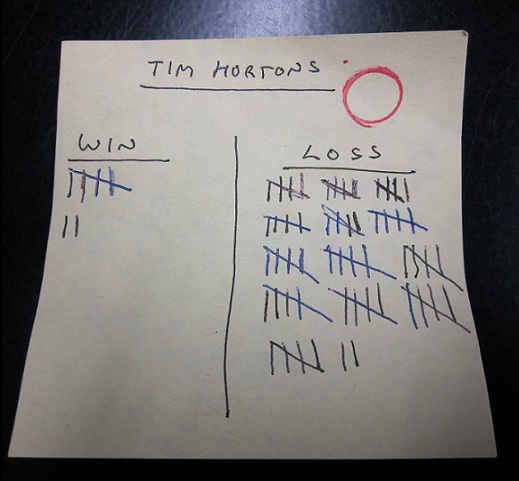Sorry, it was a long weekend, and this is the best blog post I can come up with on short notice.
The statistics are in, and I don’t believe Tim Horton’s are giving us the straight facts on their “Roll Up The Rim”…

First and foremost – don’t laugh at how much coffee I drink. I’ve heard it all.
Don’t forget that in my business, “going for coffee” is something we do to meet new clients, and I end up drinking a LOT of coffee during the course of a week. Having said that, I would likely drink a substantial amount regardless…
So Tim Horton’s says that “1 in 6 wins,” but my results say otherwise.
Having consumed seventy-four coffees during the course of the promotion, I won only seven times, or 9.46%.
“One in six” equates to 16.67%, so we are ways off.
The question becomes: how large a sample size do you need to compare notes?
If you took a sample size of one hundred, would that be enough? Maybe you’d win 19 times, maybe only 14, but with a sample size that large, you should be clustered around the 16.67 mark, no?
So my sample size is a bit smaller, but I still believe it’s large enough to produce accurate results.
What does this mean for the truths behind Tim Horton’s campaign? Is there a chance that they’re just flat-out lying? There have been a few human-interest stories on the news about the lack of winning cups in the Roll Up The Rim contest, and normally, I would assume those are just people complaining for the sake of complaining. But having seen the results first-hand, I’m not so sure anymore…































TS83
at 2:02 pm
We will not stand for this! We are the 99%!
…
..
.
(or something to that effect)
dave
at 2:36 pm
Your sample size has a fairly high level of credibility at about 97%. ie. there is a 3% chance that Tim Horton’s contention is correct and the odds of winning are 1/6.
You can use this calculator here
http://www.mccallum-layton.co.uk/stats/ConfidenceIntervalCalcProportions.aspx
Note that the calculator is for a “two sided” confidence interval, but you only care about the “one side” ie. your result is 9.5%, and you want to test the odds of 16.6% (ie +7.1%), but not 2.4% (ie one side only). So when the calculator states 95%, really it means 97.5% for a one sided test.
Scott
at 4:16 pm
There is no way that Tim Hortons’ Roll Up the Rim campaign truly yields 1 winner out of 6 as they claim. No way.
Darren
at 6:28 pm
I would think that for the odds to really work for you you would have to buy all the drinks at one time. For example, if you bought 24 random drinks it could be a coin toss, but if you buy 24 at one time it should be reasonable to expect 4 wins.
I know in the past when I have been working on large jobs and the foreman bought a drink for everyone, the winning percentage was consistent with the odds stated by tim hortons.
nate
at 8:18 pm
My highschool math days are long gone but I had the following calculation (anyone who’s more familiar with this, please correct any error, because my memory’s kinda foggy):
This is a Bernoulli trial (I believe). You can reconsider the problem like this… Assume the odds given by Tim Hortons are true (1/6). This is like asking, If I rolled a die 74 times, what are the odds that I would roll a ‘1’ exactly 7 times?
Probability(rolling 1 7 times) = (n choose r) • p^r • (1-p)^(n-r)
where n= number of trials, r is # desired events, p=probability of event occurring.
(74 choose 7) • (1/6)^7 • (5/6)^67 = 0.03183968
So there is a 3.2% chance of your results occurring. If my math is correct, which it may not be 🙂
Is that really so unlikely then? You’ll have to decide…
jeff316
at 9:10 am
I went three for seven this year. Won two coffees and a doughnut. Not that anyone cares.
Krupo
at 11:09 pm
I went 1 for 1. Sorry Dave, I think I stole one of your wins.